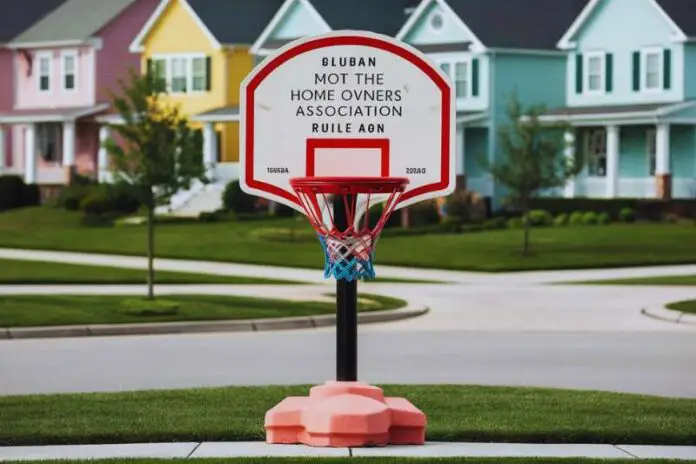HOA Rules on Basketball Hoops vary by community, often restricting placement and use. Many HOAs require approval before installation to ensure aesthetic harmony.
Homeowners Associations (HOAs) play an important role in maintaining the visual appeal and uniformity of residential neighborhoods. Understanding the specific HOA rules regarding basketball hoops is important for homeowners who wish to install one. These regulations may dictate the type of hoop allowed, permissible locations, and usage hours to minimize disruption within the community.
It’s essential to review your HOA’s covenants, conditions, and restrictions (CC&Rs) before purchasing or setting up a basketball hoop. This proactive step helps avoid potential conflicts or the need for costly adjustments later. Engaging with your HOA board can provide clarity on the guidelines and facilitate a smoother approval process. Compliance with these rules not only reflects respect for community standards but also ensures that your home basketball setup contributes positively to the neighborhood’s enjoyment and property values.
HOA Rules On Basketball Hoops
Understanding HOA guidelines is important for homeowners. These rules often impact residential basketball hoop installations. Homeowners associations (HOAs) commonly have specific regulations regarding the placement, size, and style of basketball hoops to maintain neighborhood aesthetics and safety. Familiarizing yourself with these rules can prevent potential disputes and fines. Proper knowledge ensures you can enjoy your home basketball court while respecting your community’s standards.
Common Restrictions For Basketball Hoops
Many HOA rules regulate the height and size of basketball hoops. A common maximum height is 10 feet, aligning with NBA standards. Some associations also limit the backboard to a maximum of 54 inches wide. Adjustable hoops are often preferred, allowing for changes in height.
Safety considerations also play a big role in placement rules. Hoops must often be set back from the street to avoid balls entering traffic. They should also not obstruct sidewalks or public pathways. It ensures safety for both players and the community.

The Approval Process
Before setting up your basketball hoop, review the HOA guidelines. This ensures compliance with community standards. Obtain the rules and regulations document, typically found on the HOA’s website or at their office.
Next, fill out the request form provided by your HOA. Detail your plans for the basketball hoop’s location, height, and design. Attach a sketch or photo of the hoop to illustrate your proposal.
Submit the form according to the HOA’s preferred method, which may be email, postal mail, or in person. Await the HOA’s decision before proceeding with installation. This process can take several weeks, so plan accordingly.
Navigating Disputes
Effective communication strategies are vital in resolving disputes over basketball hoops in HOA communities.
Begin by reviewing your HOA’s rules and regulations. Ensure you understand the specific guidelines regarding basketball hoops.
Open a dialogue with the HOA board by writing a clear and concise letter. Outline your concerns and suggest reasonable adjustments.
It’s essential to remain respectful and patient throughout the process. This approach can help facilitate a positive outcome.
Should initial attempts fail, consider mediation. This involves a neutral third party who can assist in reaching a mutual agreement.
Resolution paths may vary, but formal mediation can often prevent escalation to legal action. This saves time and resources for all involved.

Success Stories
Case Studies of Approved Installations reveal key strategies. Successful homeowners share their experiences. One common factor was engaging with the HOA early. They presented detailed plans and showed how their hoops would not obstruct views or traffic.
Documentation proved important. Homeowners provided photos of the proposed area. They also submitted manufacturer specifications for the hoops. This demonstrated commitment to safety and aesthetics.
- Early dialogue with HOA
- Clear, detailed plans submission
- Visual aids like photos used
- Specifications for safety and design
Compromise also played a role. Some homeowners agreed to restrict playing times. This minimized noise concerns. Others chose portable hoops to ease worries about permanent changes.
Maintaining Compliance
Regular maintenance of basketball hoops ensures compliance with HomeOwners Associations rules. Check for stability and wear to prevent accidents. Clean the backboard, net, and rim regularly for a neat appearance. Inspect the hoop’s height to align with the approved measurements. Secure all bolts and nuts to avoid noise complaints.
Keep up-to-date with HOA regulations as they may change. Attend meetings or subscribe to newsletters for the latest updates. This proactive approach will keep your basketball hoop within regulations. Consult with the HOA board if unclear about any changes.
Frequently Asked Questions
Can HOA Ban Basketball Hoops?
Many HOAs have regulations that can prohibit or restrict the installation of basketball hoops, often due to aesthetic concerns or safety issues.
Are Portable Basketball Hoops HOA-friendly?
Portable basketball hoops may be allowed by some HOAs, but often with specific guidelines regarding their placement and usage times.
How To Request HOA Approval For Hoops?
Submit a written request to your HOA board detailing the basketball hoop specifications and how it adheres to community rules.
What Are Common HOA Restrictions On Hoops?
HOA restrictions typically include height, type, location, and use duration of basketball hoops to maintain community uniformity and safety.
Does HOA Insurance Cover Basketball Injuries?
HOA insurance generally covers injuries in common areas, but it’s less likely to cover accidents related to personal basketball hoop use on private property.
Conclusion
Navigating HOA regulations for basketball hoops can be a slam dunk with the right knowledge. Remember to review your community’s guidelines, seek approval if necessary, and consider portable options for compliance. By respecting these rules, you’ll ensure fun on the court doesn’t lead to penalties.
Keep playing and stay neighborly!


